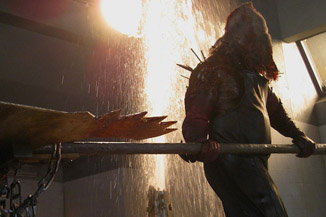|
|
What Went Right: Resident Evil Part IIBy Shalimar SahotaSeptember 12, 2012
The film is the most removed when compared to the videogames, and probably shouldn’t really have worked. The majority of it is also set in broad daylight (possibly taking its cue from the opening half of Resident Evil 4). The most absurd moment comes when Umbrella scientists attempt to domesticate a zombie, only it struggles with a toy (putting a star shaped block in a circular hole), causing it to get angry and kill the scientists. As well as the Resident Evil name, the success of Extinction likely comes down to keeping to the videogame-like formula, something that is somewhat inherent in all of the films. Alice picks up items and clues (a diary which hints at a safe area in Alaska), new weapons (two kukri knives), disposes of zombies (the super undead kind), builds up her experience points (or telekinetic powers), and finally takes on the end of level boss (a mutated Dr. Isaacs/Tyrant). The film ended with a pullback shot revealing plenty of Alice clones. Who’s going to say no to another sequel with multiple Milla Jovovich’s? Released in September 2007, it appeared to bring out the same number of fans in the US, with an opening weekend of $23.6 million. It followed the same pattern as the previous film, with a domestic total of $50.6 million. An overseas gross brought its worldwide takings up to $147.7 million. The film was a success.
[ View other columns by Shalimar Sahota ]
[ View other What Went Right columns ]
[ Email this column ]
|

|
|
|

|
Friday, November 1, 2024
© 2024 Box Office Prophets, a division of One Of Us, Inc.


